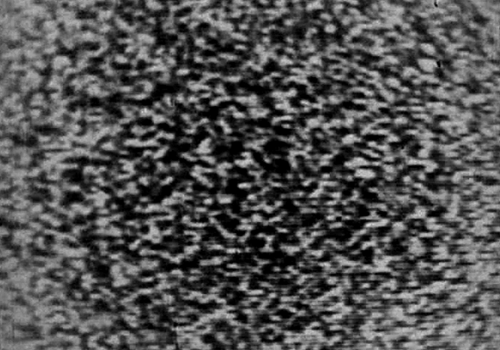White Noise
A film program curated by Florian Wüst
22 September 2012
Black Sun Cinema @ Triskel Arts Centre, Cork
16 October 2012
Experimental Film Club @ Irish Film Institute, Dublin
30 April 2013
Kino Arsenal, Berlin
15 May 2013
Blickle Kino im 21er Haus, Vienna

625, Wilhelm & Birgit Hein, 1969
"The small boy remained at the TV set, within inches of the dark screen, crying softly, uncertainly, in low heaves and swells."
—Don DeLillo, White Noise
In Don DeLillo's 1984 novel White Noise, Jack Gladney and his wife Babette, who live in a small university town and head a loose-knit family, are both obsessed with death. They try to overcome their fear, which is constantly fueled by the eerie, media saturated world of rampant consumerism and manmade disasters they live in, through the search for regenerative forces. What sets the book apart from the postmodern trends of the period is the notion of infant insight, the child being gifted with an intuitive perception of truth. Consequently, White Noise abounds with extensive discussions about death and afterlife, a concern that is symptomatic of a nostalgia for a mode of experience that lies beyond the stereotyping and banalizing powers of the media, a mode of experience not subject to simulation. "In a culture marked by an implosive de-differentiation of the image and its referent, the nonfigurability of death seems like a guarantee of a domain of human experience that can transcend hyperreality." (Paul Maltby)
In communication theory, "white noise" describes the superimposition of frequencies over a wide spectrum that renders signals unintelligible. This applies to sound as well as to the field of the electronic image. In analogue video and television, noise is a random pattern of black and white dots or "snow" that appears on the screen when no transmission signal is obtained by the antenna receiver and other display devices. By referring to the metaphor of "white noise", DeLillo illustrates, on the one hand, the entropic state of postmodern culture, where communications are degraded by triviality and irrelevance, yet, on the other hand, he seems to suggest that in the incoherent mix of frequencies there is, as it were, a certain wavelength that carries a flow of spiritually charged meaning—an undercurrent of "nameless energies".
The significance of "white noise", both as an unintelligible composition of signals and as a pure experience, provides the vantage point from which to view this homonymous program of historical and contemporary experimental films. The early work of German experimental filmmakers Wilhelm and Birgit Hein is therefore central to it. The Heins were not only known for their own, largely self-made films, but also for their Cologne based cinema activities and exhibition making. The four films presented in White Noise range from 1968 to 1977 and cover the period during which the Heins concentrated on structural film. By examining the primary material nature of the medium, they broke with the illusionist impression of reality in film.
White Noise reflects the deconstruction of cinema and television not only as a monolithic system of representation and a dream factory, but also as an instrument of corporate power and social control. Images of (human) disfigurement and the mysteries of childhood mix with the penetration of the senses on different levels. The combination of poetic collage, critical analysis, and radical abstraction intends to challenge the emotional as well as physical capacities of the audience.
The program was originally conceived for Black Sun Cinema, Cork, in association with Sirius Arts Centre, Cobh.
My Name is Oona, Gunvor Nelson, USA 1969, 10'
Rohfilm, Wilhelm & Birgit Hein, West Germany 1968, 22'
Sun in Your Head, Wolf Vostell, West Germany 1963, 7'
Khalil, Shaun, A Woman under the Influence, Sharon Lockhart, USA 1994, 16'
Charles Manson, Wilhelm & Birgit Hein, West Germany 1970, 5'
--- interval ---
Television Delivers People, Richard Serra & Carlota Fay Schoolman, USA 1973, 6'
625, Wilhelm & Birgit Hein, West Germany 1969, 34'
Energie!, Thorsten Fleisch, Germany 2007, 5'
Contre-Jour, Christoph Girardet & Matthias Müller, Germany 2009, 11'
Weissfilm, Wilhelm & Birgit Hein, West Germany 1977, 5'